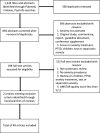A systematic review of reviews on the prevalence of anxiety disorders in adult populations
- PMID: 27458547
- PMCID: PMC4951626
- DOI: 10.1002/brb3.497
A systematic review of reviews on the prevalence of anxiety disorders in adult populations
Abstract
Background: A fragmented research field exists on the prevalence of anxiety disorders. Here, we present the results of a systematic review of reviews on this topic. We included the highest quality studies to inform practice and policy on this issue.
Method: Using PRISMA methodology, extensive electronic and manual citation searches were performed to identify relevant reviews. Screening, data extraction, and quality assessment were undertaken by two reviewers. Inclusion criteria consisted of systematic reviews or meta-analyses on the prevalence of anxiety disorders that fulfilled at least half of the AMSTAR quality criteria.
Results: We identified a total of 48 reviews and described the prevalence of anxiety across population subgroups and settings, as reported by these studies. Despite the high heterogeneity of prevalence estimates across primary studies, there was emerging and compelling evidence of substantial prevalence of anxiety disorders generally (3.8-25%), and particularly in women (5.2-8.7%); young adults (2.5-9.1%); people with chronic diseases (1.4-70%); and individuals from Euro/Anglo cultures (3.8-10.4%) versus individuals from Indo/Asian (2.8%), African (4.4%), Central/Eastern European (3.2%), North African/Middle Eastern (4.9%), and Ibero/Latin cultures (6.2%).
Conclusions: The prevalence of anxiety disorders is high in population subgroups across the globe. Recent research has expanded its focus to Asian countries, an increasingly greater number of physical and psychiatric conditions, and traumatic events associated with anxiety. Further research on illness trajectories and anxiety levels pre- and post-treatment is needed. Few studies have been conducted in developing and under-developed parts of the world and have little representation in the global literature.
Keywords: Anxiety; anxiety disorders; demographics; epidemiology; international; mental disorders; prevalence.
Figures
References
-
- American Psychiatric Association . 2010. Diagnostic and statistical manual of mental disorders.
-
- Amerio, A. , Odone A., Liapsis C. C., and Ghaemi S. N.. 2014. Diagnostic validity of comorbid bipolar disorder and obsessive‐compulsive disorder: a systematic review. Acta Psychiatr. Scand. 129:343–358. - PubMed
-
- Andersen, L. N. , Kohberg M., Juul‐Kristensen B., Herborg L. G., Sogaard K., and Roessler K. K.. 2014. Psychosocial aspects of everyday life with chronic musculoskeletal pain: a systematic review. Scand. J. Pain 5:131–148. - PubMed
-
- Arden‐Close, E. , Gidron Y., and Moss‐Morris R.. 2008. Psychological distress and its correlates in ovarian cancer: a systematic review. Psychooncology 17:1061–1072. - PubMed
-
- Baxter, A. J. , Scott K. M., Vos T., and Whiteford H. A.. 2013. Global prevalence of anxiety disorders: a systematic review and meta‐regression. Psychol. Med. 43:897–910. - PubMed
Publication types
MeSH terms
LinkOut - more resources
Full Text Sources
Other Literature Sources
Medical
Research Materials


